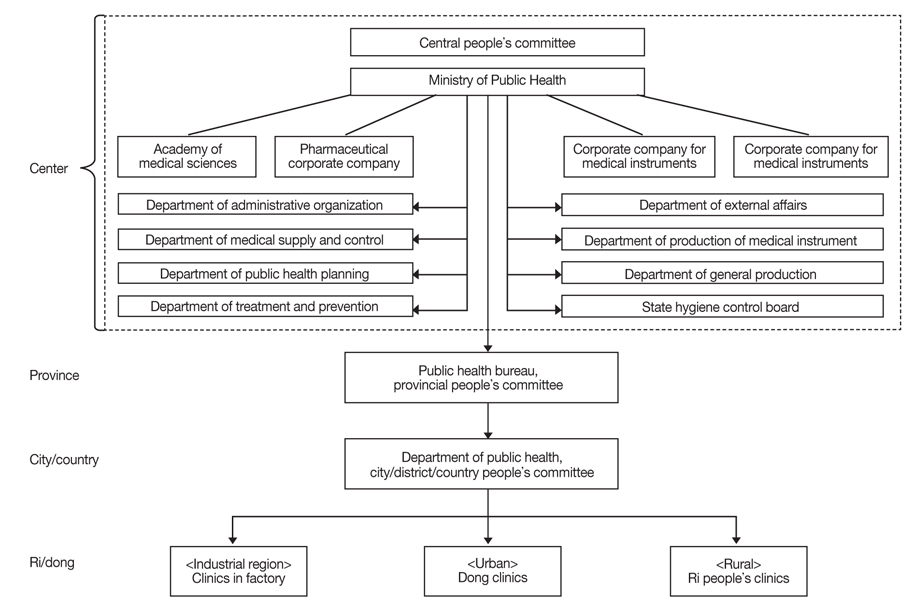J Korean Med Assoc.
2013 May;56(5):358-367.
Overview of healthcare system in North Korea
- Affiliations
-
- 1Asian Institute for Bioethics and Health Law, Yonsei University, Seoul, Korea. syoonkim@yuhs.ac.kr
- 2Department of Medical Law and Ethics, Yonsei University College of Medicine, Seoul, Korea.
- 3Graduate Program in Medical Law & Ethics, Graduate School of Yonsei University, Seoul, Korea.
Abstract
- In this study, we analyzed the healthcare system of North Korea using Kleczkowski's model which categorizes national healthcare infrastructure into five components: health resources, organization, healthcare delivery system, economic support, and management. It was found that the healthcare system in North Korea, which provides clinical medicine, Koryo medicine and preventive medicine, is constituted of a physician system of independent geographic sectors and centralized delivery system while maintaining free universal health coverage. These systems are all managed by the government and the People's Committee Party. However, North Korea has been confronted with severe economic difficulties since the 1990s, such that we question whether the healthcare system has been able to function properly despite of the lack of resources in general throughout the country.
Keyword
MeSH Terms
Figure
Reference
-
1. Kim IS. Kim Il-Seong jeojak seonjip. Pyeongyang: Choseon Rodongdang Chulpansa;1967.2. World Health Organization. World health statistics 2012. Geneva: World Health Organization;2012.3. World Health Organization. World health statistics 2011. Geneva: World Health Organization;2011.4. World Health Organization. World health statistics 2009. Geneva: World Health Organization;2009.5. World Health Organization. The world health report 2000. Health systems: improving performance. Geneva: World Health Organization;2000.6. Kleczkowski BM, Roemer MI, van der Werff A. National health systems and their reorientation towards health for all: guidance for policy-making. Geneva: World Health Organization;1984.7. Moon OR. Health care system in North Korea. Seoul: Ajou Institute of Korean Unification and Health Care;2001.8. Seon HS. Working life and labor of the North Korean. Seoul: The Bureau of Public Information;1994.9. Moon OR. North Korea's health care system and health status. Proceedings of Korean Academy of Health Policy and Management. 1990; Seoul, Korea. Seoul: Korean Academy of Health Policy and Management;1990. p. 34–43.10. Moon OR. Health care polices of North Korea. J Korean Med Assoc. 1995; 38:261–267.11. Korea Institute for National Unification. North Korea introduction 2009. Seoul: Korea Institute for National Unification;2009.12. World Health Organization. WHO country cooperation strategy: Democratic People's Republic of Korea 2009-2013. Geneva: World Health Organization;2009.13. United Nations Children's Fund. Democratic People's Republic of Korea multiple indicator cluster survey 2009: final report. New York: United Nations Children's Fund;2010.14. United Nations Children's Fund. Country profile-DPRK. New York: United Nations Children's Fund;2009.15. Lee HK. Study on the limped and changed North Korean health care system: based on the latter half of 1990 [dissertation]. Masan: Kyungnam University;2009.16. Yang MS. The economic structural changes of North Korean in 2000s. KDI Rev North Korean Econ. 2007; (5):3–23.17. World Health Organization. Assessment of the local pharmaceutical production in DPRK: mission report Alain Kupferman. Geneva: World Health Organization;2008.18. Choseon Chungang Tongsinsa. Choseon Chungang yeongam. Pyeongyang: Choseon Chungang Tongsinsa;1982.19. Lim B, Park J, Han C. Attempts to utilize and integrate traditional medicine in North Korea. J Altern Complement Med. 2009; 15:217–223.
Article20. World Health Organization, Country Office for DPR Korea. Organogram of Ministry of Public Health in DPR Korea [Internet]. Pyeongyang: World Health Organization, Country Office for DPR Korea;cited 2013 Mar 28. Available from: http://www.dprk.searo.who.int/EN/Section6_9.htm.21. Lee SY, Hwang NM, Yoon KJ. A study of efficient ways of cooperation in health care and medicine between the two Korea. Seoul: Korea Institute for Health and Social Affairs;2008.22. Sung KH. Korean Academy of Medical Sciences. State of health care in North Korea. Development of health care policies for the unified Korea. Seoul: Korean Academy of Medical Sciences;1998. p. 8–28.23. Park HJ. Unification and socioculture of North Korea. Seoul: Korea Institute for National Unification;1996.24. Lee WS. Health care system in North Korea [dissertation]. Iksan: Wongwang University;1992.25. Lim GS, Kim CN, Park KM. A comparative study on the health care system of South and North Korea. J Korea Community Health Nurs Acad Soc. 2001; 15:182–201.
- Full Text Links
- Actions
-
Cited
- CITED
-
- Close
- Share
- Similar articles
-
- Mid-Term Strategic Plan for the Public Health and Medical Care Cooperation in the Korean Peninsula
- The experiences of system integration countries informing the potential unification of the Korean peninsula's healthcare system
- An Estimation of Supply and Demand for Primary Healthcare Nursing Workforce in the North Korean Region after Korean Reunification
- The Present and Future Status of Maternal and Child Health From the Perspective of Unification Medicine
- The Implications on Healthcare System of the Unified Korea: Lesson from System Integration Countries




